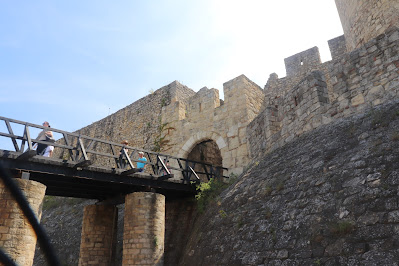 |
| Tito |
Belgrade
has a population of 2 million and 7000 years of history. We visited the mausoleum of
Tito. Today, there is a diversity of opinions about Tito. What is of
common opinion is that he was the only one who could keep these ethnicities
together. He was born here, when this was part of the Hapsburg empire. Belgrade
became the capital of the Kingdom of Yugoslavia after World War I. Serbia was
the only independent country of what formed Yugoslavia before the war. The
kingdom was an attempt to unite the separate ethnicities of Southern Slavs. For
centuries, there have been 6 ethnic regions which have been ruled by larger
empires: Romans, Hungarian, Ottoman, and the Hapsburgs. Yugoslavia was occupied by Germany in 1941. Tito organized
the resistance against Germany, creating a socialist Yugoslavia. He eliminated
his opponents to ensure he would lead the country. Yet he stood up
to Stalin to not become a Soviet Satellite Nation. In fact, in 1961 he became
head of over 100 non-aligned nations. Yugoslavia had a higher GDP than the
Soviets, people could travel everywhere, and they could buy blue jeans and
coke! Tito died on May 4th, 1980. His funeral was the fourth largest
in the 20th century with well over 130 countries sending
representatives. His birthday continued as a holiday for 8 years after his
death.
 |
| Orthodox Cathedral |
We continued to the city center, seeing the pedestrian shopping
area, the home of Nikola Tesla
(promoter of alternating current vs. Edison’s direct current), and the Orthodox
Cathedral. On the same street are a Catholic church, a synagogue, and a mosque.
We stopped inside the Orthodox church. Here we learned the key differences
between an Orthodox and Catholic church: no pews, the people stand, no statues,
no organ, and a screen covered with paintings or icons in front of the altar.
Each country’s church is led by a patriarch, and the Patriarch of Istanbul is
the first among equals.
 |
| Despot Gate in Belgrade Fortress |
In the afternoon, we visited the Belgrade Fortress
and Kalemegdan Park. Belgrade has been a pivotal military point for centuries
located at the confluence of the Sava and Danube rivers. This is the last hill
before the European plains. There have been 214 battles here and Belgrade has
been destroyed 42 times. The latest battle was when NATO bombed the city in 1999.
The Victory Monument celebrating the victory over the Ottomans stands here. It
was originally planned for Victory Square, but stands here instead, since it is
a naked man. As we walked out of the Fortress, we saw numerous young men and
women dressed in native costumes taking a break from dance competitions in the
shade. That evening we were entertained by the Talija
 |
| Serbian Dancers |

No comments:
Post a Comment